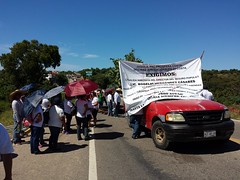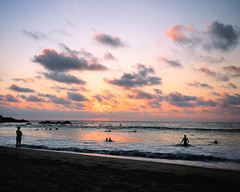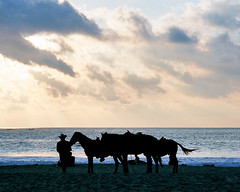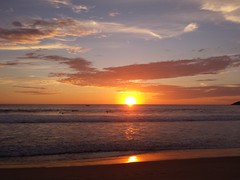Puerto Escondido
Puerto Escondido (English: "Hidden Port") is a small port and tourist center in the municipality of San Pedro Mixtepec Distrito 22 in the Mexican state of Oaxaca. Prior to the 1930s, there was no town. The bay had been used as a port intermittently to ship coffee, but there was no permanent settlement due to the lack of potable water. The name "Puerto Escondido" had roots in the legend of a woman who escaped her captors and hid here. The Nahuatl word for this area was Zicatela, meaning “place of large thorns". Today, it refers to the area's most famous beach.
Puerto Escondido is one of the most important tourist attractions on the Oaxacan coast. It caters to a more downscale and eclectic clientele than neighboring Huatulco, mostly surfers, backpackers and Mexican families. The main attractions are the beaches: Zicatela Beach hosts major surfing competitions, while other beaches have gentle waves. A large lagoon area to the west of the town is popular for fishing and birdwatching.
History
The area around Puerto Escondido had been inhabited by indigenous peoples for centuries, but no towns of any size were established during the pre-Hispanic or colonial eras. The bay was known as Bahia de la Escondida (Bay of the Hidden Woman) due to a legend associated with this place. The story states that a fierce pirate, Andrés Drake, brother of Sir Francis Drake, anchored his ship in the bay when the area was completely uninhabited, to rest for a few days unmolested by authorities.
Some weeks before, he and his crew kidnapped a young Mixtec woman from the village of Santa María Huatulco and took her prisoner. While in the bay, the woman escaped the cabin in which she was being held, and being a good swimmer, jumped overboard to get to shore and hide in the jungle just beyond the beach. Since then, the pirates referred to the woman as “La Escondida” (the hidden one) and every time the ship returned to these waters, the captain ordered his crew to search the area around the bay, however, they never found her. Hence, the area became known as the Bahía de la Escondida.
At the beginning of the 20th century, it was known as Punta Escondida (Hidden Point), then later, Puerto Escondido. At that time, it was just a small fishing village that intermittently was used to ship coffee. Back then, Puerto Escondido suffered from a lack of potable water, although the Colotepec River ran nearby. This caused people to settle in other places. Some did stay, including Nazario Castellanos and Escolástica Valencia, who were the night watchmen for the nearby coffee plantations and considered to be the town's first residents. There was no real town until the 1930s, when Puerto Escondido's activity as a port was more firmly established.
Puerto Escondido belonged to the municipality of Santa María Colotepec. However, eventually the residents petitioned to change jurisdiction to another nearby municipality, San Pedro Mixtepec, which was granted in the 1940s.
From the 1940s to the 1960s, a church was constructed and the first school was built. Wells were dug to alleviate the water supply problems, and generators bought to supply electricity to the pumps and the few streetlights. However, there were still problems getting needed outside supplies such as sugar. These commodities only arrived when a merchant ship entered the bay to sell its wares. Sometimes, this would not happen for months. Residents got by with local products such as fish, poultry, iguanas, chicken and turtle eggs. After the Sola de Vega road to the capital of Oaxaca was constructed, this problem was alleviated somewhat.
In the 1960s, Highway 200 was built, connecting Oaxacan coastal towns with Acapulco. Surfers and other tourists began to find the quiet beaches around Puerto Escondido and tourism began to flourish. Its function as a port diminished as coffee began to be transported by truck. Other infrastructure added included those to supply the area with potable water, a small airport where the Rinconada is now, mail service and some government offices. However, in the 1970s only about 400 people lived in Puerto Escondido.
With time, Puerto Escondido's importance as a tourist attraction increased, with hotels and resorts being constructed. For many years, restaurants were almost exclusively in “palapas” (thatched roof shelters) with fishermen preparing their catches; however, these have mostly given way to modern tourist facilities. Puerto Escondido is one of the most important tourist sites on the Oaxacan coast.
The community of Puerto Escondido is divided between two municipalities. The Zicatela Beach side belongs to the municipality of Santa María Colotepec and the western portion belongs to San Pedro Mixtepec. The boundary between the two municipalities is in dispute, leaving many businesses in limbo, sometimes paying taxes to both municipalities. . Puerto Escondido is lobbying for a more independent status with the Congress of the state of Oaxaca, against opposition from San Pedro Mixtepec. 69% of the municipality's population lives in Puerto Escondido. In addition to the above problems, backers of the measure stated that while the community generates most of the municipality's income, it does not receive support from the municipal seat. In August 2008, residents of Puerto Escondido blocked the highway to the municipal seat of San Pedro Mixtepec to protest the lack of money for infrastructure in the town. As of the 2009 census, Puerto Escondido had a population of 20,178
On 30 July 2009, the state congress declared Puerto Escondido to be a city. However, the declaration did not resolve the boundary dispute between San Pedro Mixtepec and Santa María Colotepec.
The City
Puerto Escondido is mostly located in the municipality of San Pedro Mixtepec in the western portion of Oaxaca's coast also known as the Emerald Coast. Its bay is adjoined by a number of rocky cliffs, which vary in height between 15 and 30 metres. The town center is located on the north side of the bay. The climate is tropical and humid, with an average annual temperature of 28 °C (82 °F) with a rainy season in the summer.
Puerto Escondido is the oldest tourist attraction in the region, and is the main centre of tourist activity, both for nationals and foreigners. The large waves of Zicatela Beach put it into the top ten surfing destinations. The port does continue to support commercial fishing activity, and it also attracts people for deep-sea fishing (esp. for sailfish).
Puerto Escondido is not as well-known or visited as other beach resort areas such as Acapulco or Cancun because there are only domestic flights, discouraging a number of visitors. Bus rides from the Oaxacan capital take seven hours over hairpin turns as the roads descend the Sierra del Sur mountain range. Most of the bus terminal coming from Oaxaca are located in the downtown.
Puerto Escondido is mostly downscale and rustic, with many small and mid-sized hotels and restaurants, but there are a few upscale hotels. Most cuisine is based on seafood and local plants, which include eleven species of banana, chocolate and coffee. It also has some Italian restaurants, which were opened by recent Italian immigrants.
The tourist center of Puerto Escondido is not a plaza but Pérez Gazga Avenue, known locally as "El Adoquin" or "La Zona Adoquinada" (the paving stone street). Beginning with a statue of Benito Juárez are found bars, hotels, cafes, restaurants, nightclubs, craft shops, Internet cafes, corner stores, tour operators and scuba diving rental. It also serves as a promenade as it parallels the main beach of the town, and is pedestrian-only after 17:00. At night it is crowded with locals and tourists. This is one of the areas to buy Mexican, especially Oaxacan, handcrafts such as loose-fitting blouses, shirts, vests, wraps, tapestries, handbags, bags, jackets, hammocks, carved stone jewelry, silver and seashell items. However, the main market in the town centre is where you get competitive Mexican prices. Away from the beach above the Adoquin is the Coastal Highway 200.
The Andador Escénico (Scenic Walkway) is a set of paths, stairs and bridges that begin at the main beach of the town and winds its way over rocky oceanside cliffs, passing below the lighthouse to a lookout the named Sueño Posible (Possible Dream). In some places the walkway is very near the ocean and gets wet from the waves.
Each year, the city celebrates Carnival which begins with the "quema de mal humor" or the burning of bad mood. This is done with an effigy with the purpose of ridding the people of bad thoughts and moods in order to enjoy the festivities.
Beaches
The main attractions of Puerto Escondido are its beaches, which have become internationally known. The area also is attractive to scuba divers because of the variety of fish, large oysters, lobsters and manta rays. Although the Pacific Coast of Mexico generally runs north–south, this section of the coast in Oaxaca runs east–west, Playa Zicatela is on the eastern end.
Puerto Escondido became famous for surfing competitions held at Zicatela Beach every year in November. The competition brings competitors from various countries. Nicknamed the "Mexican Pipeline" due to the similar power and shape of the Banzai Pipeline on the North Shore of Oahu, the wave that breaks on Zicatela Beach draws an international crowd of surfers, bodyboarders and their entourages. Mid to late summer is low season for tourists, but a prime time for waves and international tournaments. A number of international competitions such as the ESPN X Games, and the MexPipe Challenge have taken place. This beach is separated from the other beaches by a rocky outcropping called "El Morro" (the nose). The beach is 50 to 100 metres wide and four kilometres long with large waves that reach up to sixteen metres high. Lifeguards are stationed at this high-risk beach as well as on the other beaches. About half of these are professional and the other half volunteers. …
Looking for places related to Puerto Escondido?
Those are other destinations to find places related to Puerto Escondido:
























